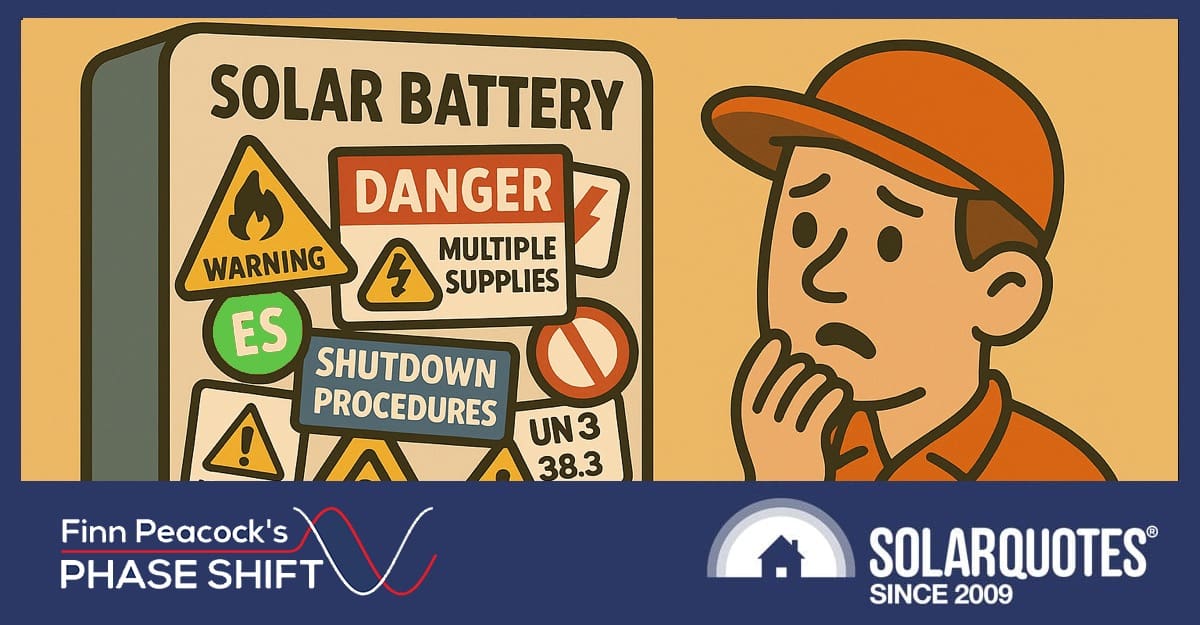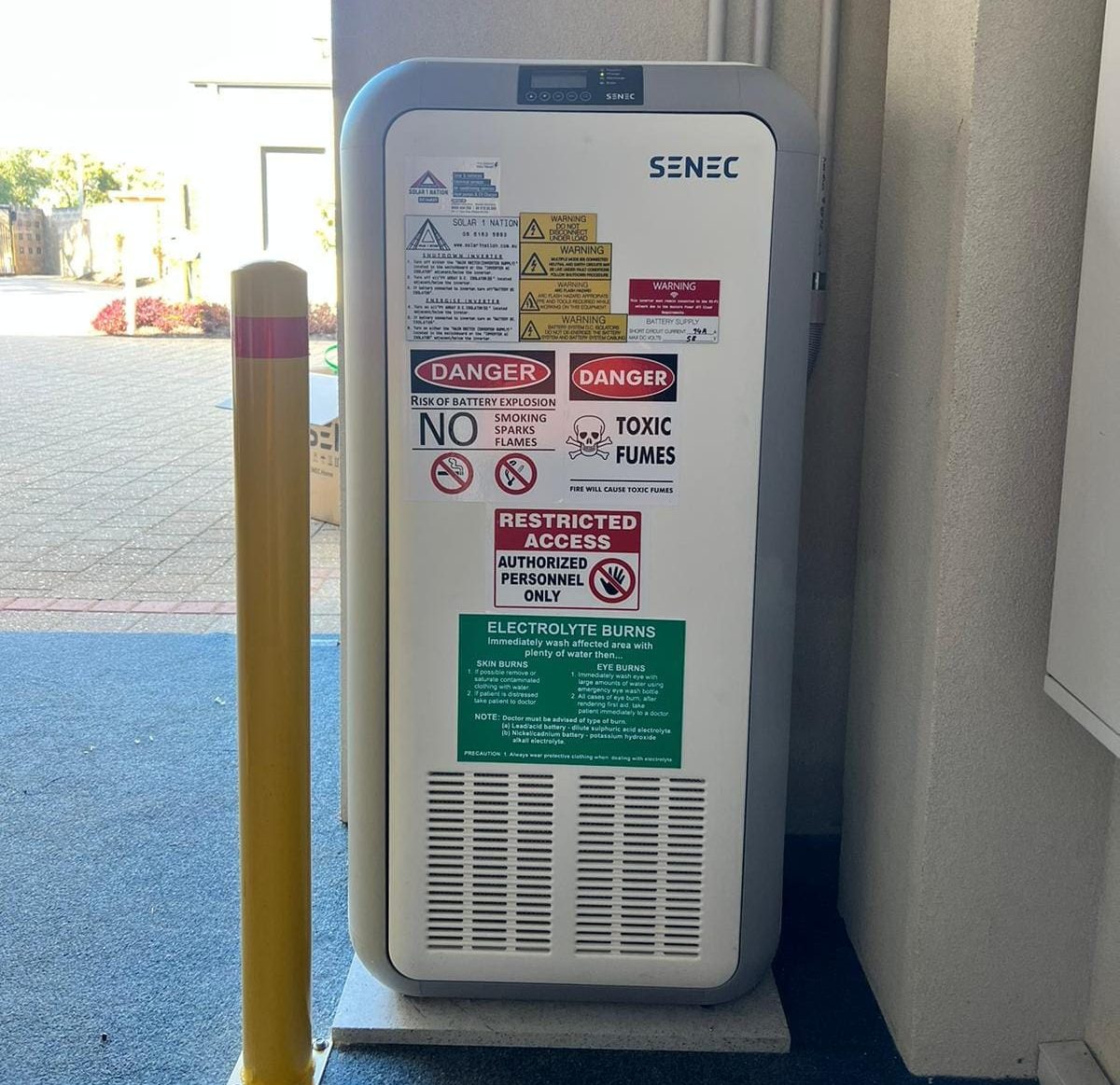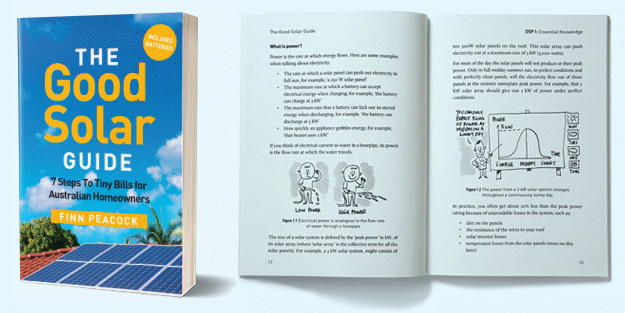
A battery covered in stickers.
Last month, the Government hosted a Productivity Summit. Tristan Edis summed it up in one brutal line:
“If introducing a road user charge for electric vehicles is the best we can do out of the Productivity Summit, then God help this country.”
He’s right. If Australia wants productivity, we don’t need to tax the most efficient cars on the roads – we need to start by asking good tradies and engineers which regulations and standards could quietly disappear without making anyone less safe.
Australia has some of the best electrical standards in the world. They’ve saved lives – I know from experience.
Some Regulations Are Necessary
Back in 2011, I was renting a home in Adelaide while building SolarQuotes. I went to change a halogen downlight and found the insulation above it blackened from heat. I knew halogen downlights and poorly installed insulation were a leading cause of house fires.
I called the property manager and explained the house had been built without the mandatory downlight covers required by Australian electrical installation standards. A few days later, he called back:
“I’ve spoken with the owner – he doesn’t think we need to do anything.”
So I paid $1,000 out of my own pocket to have a local sparkie fit covers on every downlight. Then I turned up at the renters’ tribunal with a copy of The Australian Wiring Rules under my arm. I showed the standard, proved it was mandatory, and got my $1,000 back.
That’s a standard working exactly as intended: clear, necessary, life-saving and money-saving.
But here’s where we’ve lost the plot.
The Sticker Avalanche
Take Solar Victoria’s excellent Battery Audit Checklist. To be clear – Solar Vic doesn’t write the standards, they just audit against them. But if you read through it, you’ll see the problem.
I went through the checklist line by line and sorted it into three buckets:
a) Labelling/stickers (40%)
Apart from the big ES sticker for emergency crews and other sparkies, most of this is compliance theatre.
b) Location rules (30%)
Clearances from windows, air conditioners, hot water services, pathways and more. Some of these are genuine fire/explosion issues, but most should be guidance only.
c) Genuine safety (30%)
The important stuff: correct breaker sizing, earth continuity, segregation of AC/DC cabling, no exposed live parts, proper isolation, structural adequacy of mounting surfaces. These are the things that stop electrocution, fire, or catastrophic failure.
So over two-thirds of the checklist is labelling and location rules, not genuine safety.
And when inspectors are bogged down in counting labels and measuring centimetres from windows, the risk is obvious: the critical safety issues get less attention. If you make the haystack bigger, it’s harder to see the needles.

Case in point.
From ‘Shall’ to ‘Should’
The fix doesn’t need a Productivity Commission report. It can be as simple as swapping one word in a few paragraphs.
If a rule is best practice but not critical, then say so. Replace “shall” with “should” in the relevant Australian Standard. That small shift frees installers to focus on what matters. What’s the ROI on changing one word? Astronomical.
Instead of drowning in labels, we’d have tradies focused on the breakers, earths, and isolation switches that save lives and prevent fires.
Back to Renting
But it’s not just safety. Let’s return to where I started: renters. Portable, plug-and-play batteries paired with cheap daytime tariffs could slash renters’ bills tomorrow.
But you guessed it – current standards don’t allow it.
If the Productivity Summit really wants to improve Australia’s performance, it should stop fiddling with EV taxes and start pruning the regulatory undergrowth.
The best tradies and engineers already know which regulations matter and which are just bureaucratic barnacles. Time to listen to them.
Phase Shift is a weekly opinion column by SolarQuotes founder Finn Peacock. Subscribe to SolarQuotes’ free newsletter to get it emailed to your inbox each week along with our other home electrification coverage.

 RSS - Posts
RSS - Posts



I’m thinking Nail, and then Head.
You have done it again Finn, you’ve bought the two together.
Engineers, tradies and science based economists, form a minor gaggle of them from across the country to advise the productivity commission on how to get the place into gear.
Then do it. Win win.
Thanks Finn for raising this important issue. So called “safety by sticker graffiti” is out of control. In Germany there is only one sticker, symbol of house with solar, and the attitude is as a licensed electrician you should know what you are doing.
Of course some basic end user information is important too such as a shutdown procedure and warnings of hazards, however, the current standard says these are to be attached adjacent to the equipment, not plastered all over the product.
My last gribe is that often the wrong labels are attached, such as the green electrolyte spillage sign to a lithium-ion battery, which is for flooded electrolyte batteries and also requires bunding around the unit. So if you’re going to put the wrong sticker on, then logically you should be putting the unneeded bunding too!
I ran audit teams for years. Check lists were the bane of my life. I wanted my audit teams to look at what was there, see if it was fit for purpose, not tick boxes, yet my boss insisted we had check lists. They were as basic as I could get away with.
as the pic Finn shared shows half those lables are wrong.
and about a third never need to be used at all.
it can be on 2 stickers.
danger: energy storage battery hazardous voltage & current inside keep area clear. battery type:
and a second label with the shutdown process
and that’s it.
Renters *could* charge a small (ish) battery from a wall socket and use the outlets to power loads like fridges and maybe do some cooking.
Those in houses might be able to thow some used solar panels on the lawn and charge via solar.
Legal? Probably not.
And I would like to see us look at enabling Balcony Solar for those in apartments.
If you get a power station and only use the wall socket/solar options it’s perfectly legal it just limits you to 10/15amps depending on available sockets on both ends.
“Won’t do anything for hardwired devices generally without having them rewired to swap to a generator socket though”
I did previously price up such a system to take my room off-grid without effecting the current solar contract.
Ended up too expensive when taking into account when im expecting to be able to upgrade the main system “2027/2028”
Charging EV owners as the sole outcome of the Productivity Commission reminds me of the upping of the gas excise once there was a sufficient number of vehicles running on gas conversions.
That would have led to numbers of gas conversion joints going broke. Instead of supporting the uptake of EVs, most states, like WA, have now stopped the EV rebate, which used to be $3,500 and which supported the uptake.
A cost-benefit study would have shown net benefits like a reduction in oil imports, health benefits, charging EVs from solar requiring less coal/gas for energy production, etc.
As Churchill said: “Increasing taxation as a means of wealth creation is like a man standing in a bucket trying to lift himself up”!
It’s like a Yes Minister episode. Correctly there’s a focus on safety. Then it becomes somebody’s job to implement the safety requirements. That’s when the overload happens, because that person’s whole reason for having employment is to make safety happen, so it becomes a sort of tunnel vision for them, almost nothing else matters.
i see this often with roadworks now too. Gone are the days of some sort of sensible risk management (not least because drivers are mostly crazy). Now whole sections of major highways get shunted down to 40 km/h with signage and closed lanes, just so somebody can cut the grass in the middle of the road. Or we had an older work trip and fall at work the other day. That led to several weeks of the most gobsmacking paperwork and medical and risk assessments. All driven by the in-house risk and safety team, they see that as their job.
It’s not just batteries. Have you seen the manual from any sort of power tool made in the last decade. 25 pages of safety warnings and disclaimers ( never read of course), a few pages of cryptic diagram that look like leftovers from a game of Pictionary, and a few words hidden somewhere that might actually be useful.
Totally agree Andrew. I wish there was a section that was headed “If you already know not to stick this power drill up your left nostril and turn it on, then start reading from here.”
From the other side of the page, let’s look at the OH&S issue.
Stickers aside, the OH&S regulations will be redundant when people are no longer injured or killed at work. Something that happens all too often.
The time and money spent on all of the regs, stickers, bollards around the batteries, etc, is a fraction of the cost to a business compared to what happens when someone is injured or killed.
Most smaller businesses will go under and disappear if someone is seriously injured or killed. And, in Victoria, at least, we have industrial manslaughter laws, meaning the boss and any key worker on a job will be jailed if someone dies and safety precautions are not undertaken.
A couple of stickers wont hurt, but we could streamline it. Remember there are people out there who should not be doing certain jobs because they are “cowboys”, but a death is just that. If one sign, or day of extra training can prevent it, then it is worth it.
Otherwise, someone is hospitalised, or never goes home.
Regulation overload is rife right across Australia. It is because safety regulation has become a big industry and the more regulations the bigger it can become. People get paid to come up with them. Others get paid to inspect them. Tradies get driven mad trying to comply with them. Consumers have to pay the higher cost all this compliance causes to get anything done.
As has been pointed out maybe half of the regulations we are stuck with are overkill and contribute little or nothing to safety so could become recommendations rather than rules.
I recently had a battery/inverter system installed.
I complained to the installation company that the main equipment was installed on a brick wall and not ,in my vast experience of installing consumer devices, that with 8 attachment point’s on the equipment having 50% in the brickwork, with the balance in mortar, is safe or even acceptable.
I ran this question by both CEC and ESV who seemed very uninterested!
Am I just out of touch with what is acceptable these days?
My motto: ( done right, done once) lost on the new generation of installer’s as opposed to tradesmen, technicians of my era?
You are so right about all the sticker’s that adorn the cabinet, obviously designed to cover the most inept and really clueless consumer.
As they say-can’t fix stupid!
?
“if you make it idiot proof the world will create a bigger idiot.”
some things are inherently dangerous.
they removed plant operators tickets for front end loaders, dozers, graders, excavators etc saying they were no longer high risk plant. BUT the danger hasn’t changed they are still just as dangerous as they always were, what changed is safe working procedures such as exclusion of workers from the working area especially the working radius. high visibility clothing, blind spot mirrors, 2 way radio communication and the like.
but we can get regulatory paralysis where all the red tape bullshit just slows things to a crawl.
I agree with Finn here.
One of the most ubiquitous things in every garage or garden shed is a five litre container of mower petrol. If full, it has about 48 kWh of energy stored in it.
It’s highly volatile, it can spill and spread easily. It can be lit up by mere static electricity.
Where are the safety stickers, MSDSs, clearances, barriers to habitable rooms, bollards, bunds, etc?
Your calculation is based on potential energy and not chemistry , lithium fires are nothing like a fuel fire , granted both dangerous but I can tell you for sure that lithium batteries are a next level of dangerous go look at all the cargo ships with evs catch on fire its almost impossible to put them out thats not the case with a fuel fire. On that note I’m hugely in favour of sodium ion batteries which in contrast to lithium are muchhh more safe and also better temp range, I see companies like CATL banking on them being the future vs lithium.
well a fire at sea is always difficult to deal with no matter what is burning.
cars are just rolling platforms full of fuel. every thing a car is made from apart from the steel will burn readily as most of it is made from petroleum.
and it doesn’t matter the propulsion source.
while you have a unlimited water supply you dont have unlimited weight capacity on the vessel.
that water has to be pumped back over the side.
your limited by how much water you can pump off the vessel or get to drain off.
a mariner’s biggest fear is fire on board. as fighting fire has the secondary danger capsize or sinking.
a family friend is a master mariner with over 30 yrs at sea.
Agree on the stickers/labels but not on the shall to should. There are too many crappy installers that without black and white mandatory requirements will do stupid things and there will be no way to force them to fix them.
I kind of think of safety stickers like the the Van Halen “no brown M&Ms backstage” rule. If you can’t be compliant with a simple sticker then you’re probably not going comply with the actual important stuff. Good thing that stickers are cheap..
Unfortunately there are shonky operators who will take advantages of any losse wordings in any guidelines.
I have encountered government contracts that are so specific that no one would measure it in real life. For example, the government contract may specify the standard flow rate m³/min and sustained temperature of air condition provision.
It was because many landlords never put money back to the maintenance to provide proper service. The landlords always win the legal arguments with loose wording contracts.
If it wasn’t for proper legal specifications protecting renters, Finn, I doubt you would have your $1,000 back in 2011.
Red tapes accumulate, but you need to root out many questionable characters in your industry before reducing those regulations.
Easy to put a tax on than to do real productivity. like return SAA Standards to government and have them free to all
Childcare owner here. Every time a government person walks into one of our centres, we have to put one or two new notices up on the wall.
There are so many, parent’s eye just glaze over and nobody reads them.
We wait a few months and then quietly take them down.